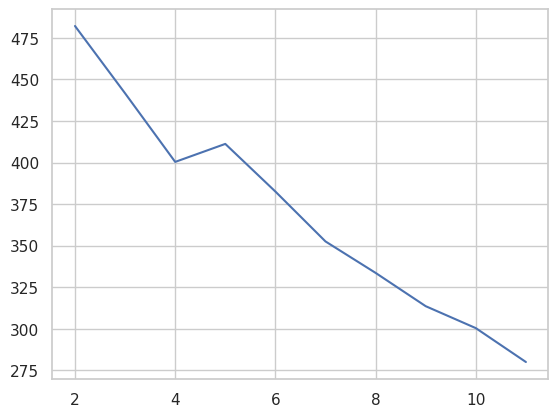Additional methods#
This notebooks provides an overview of built-in clustering performance evaluation, ways of accessing individual labels resulting from clustering and saving the object to disk.
Clustering performance evaluation#
Clustergam includes handy wrappers around a selection of clustering performance metrics offered by
scikit-learn. Data which were originally computed on GPU are converted to numpy on the fly.
Let’s load the data and fit clustergram on Palmer penguins dataset. See the Introduction for its overview.
import seaborn
from sklearn.preprocessing import scale
from clustergram import Clustergram
seaborn.set(style='whitegrid')
df = seaborn.load_dataset('penguins')
data = scale(df.drop(columns=['species', 'island', 'sex']).dropna())
cgram = Clustergram(range(1, 12), n_init=10, verbose=False)
cgram.fit(data)
Matplotlib is building the font cache; this may take a moment.
Clustergram(k_range=range(1, 12), backend='sklearn', method='kmeans', kwargs={'n_init': 10})
Silhouette score#
Compute the mean Silhouette Coefficient of all samples. See scikit-learn documentation for details.
cgram.silhouette_score()
2 0.531540
3 0.447219
4 0.399584
5 0.378892
6 0.367996
7 0.334723
8 0.298202
9 0.285780
10 0.284037
11 0.253290
Name: silhouette_score, dtype: float64
Once computed, resulting Series is available as cgram.silhouette_. Calling the original method will recompute the score.
cgram.silhouette_.plot();

Calinski and Harabasz score#
Compute the Calinski and Harabasz score, also known as the Variance Ratio Criterion. See scikit-learn documentation for details.
cgram.calinski_harabasz_score()
2 482.191469
3 441.677075
4 400.410025
5 411.242581
6 382.569709
7 352.545728
8 333.623814
9 313.586434
10 300.388055
11 279.995712
Name: calinski_harabasz_score, dtype: float64
Once computed, resulting Series is available as cgram.calinski_harabasz_. Calling the original method will recompute the score.
cgram.calinski_harabasz_.plot();

Davies-Bouldin score#
Compute the Davies-Bouldin score. See scikit-learn documentation for details.
cgram.davies_bouldin_score()
2 0.714064
3 0.943553
4 0.944215
5 0.971103
6 0.995130
7 1.043694
8 1.146926
9 1.221874
10 1.210427
11 1.293639
Name: davies_bouldin_score, dtype: float64
Once computed, resulting Series is available as cgram.davies_bouldin_. Calling the original method will recompute the score.
cgram.davies_bouldin_.plot();

Acessing labels#
Clustergram stores resulting labels for each of the tested options, which can be accessed as:
cgram.labels_
| 1 | 2 | 3 | 4 | 5 | 6 | 7 | 8 | 9 | 10 | 11 | |
|---|---|---|---|---|---|---|---|---|---|---|---|
| 0 | 0 | 0 | 2 | 2 | 2 | 2 | 0 | 5 | 1 | 5 | 8 |
| 1 | 0 | 0 | 2 | 2 | 2 | 2 | 0 | 2 | 1 | 9 | 9 |
| 2 | 0 | 0 | 2 | 2 | 2 | 2 | 0 | 2 | 1 | 9 | 9 |
| 3 | 0 | 0 | 2 | 2 | 2 | 2 | 0 | 5 | 1 | 5 | 8 |
| 4 | 0 | 0 | 2 | 2 | 0 | 4 | 3 | 5 | 8 | 7 | 10 |
| ... | ... | ... | ... | ... | ... | ... | ... | ... | ... | ... | ... |
| 337 | 0 | 1 | 0 | 3 | 1 | 3 | 4 | 3 | 0 | 6 | 6 |
| 338 | 0 | 1 | 0 | 3 | 1 | 3 | 4 | 3 | 0 | 6 | 6 |
| 339 | 0 | 1 | 0 | 0 | 4 | 1 | 6 | 6 | 6 | 4 | 4 |
| 340 | 0 | 1 | 0 | 3 | 1 | 3 | 1 | 1 | 2 | 1 | 6 |
| 341 | 0 | 1 | 0 | 0 | 4 | 1 | 1 | 1 | 2 | 1 | 1 |
342 rows × 11 columns
Saving clustergram#
If you want to save your computed clustergram.Clustergram object to a disk, you can use pickle library:
import pickle
with open('clustergram.pickle','wb') as f:
pickle.dump(cgram, f)
with open('clustergram.pickle','rb') as f:
loaded = pickle.load(f)
